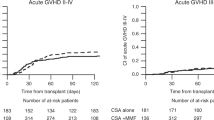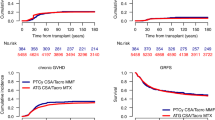Abstract
In order to test whether circumvention of clinical resistance can be obtained in common solid tumours by targeting different drug resistance mechanisms, a phase I clinical and immunological study was designed. The purpose of the study was to determine the dose of cyclosporin A (CsA), in combination with doxorubicin (DOX) and ifosfamide (IFX), needed to achieve steady-state whole-blood levels of 2000 ng ml-1 and the associated toxicity of this combination. Treatment consisted of CsA 5 mg kg-1 as a 2 h loading infusion, followed by a CsA 3 day continuous infusion (c.i.) (days 1-3) at doses that were escalated from 10 to 18 mg kg-1 day-1. Chemotherapy consisted of DOX 55 mg m-2 by i.v. 24 h c.i. (day 2) and IFX 2 g m-2 i.v. over 1 h on days 1 and 3. Treatments were repeated every 4 weeks. Eighteen patients with previously treated resistant solid tumours received 39 cycles. Mean steady-state CsA levels > or = 2000 ng ml-1 were reached at 5 mg kg-1 loading dose followed by a 3 day c.i. of 16 mg kg-1 day-1 or greater. Haematological toxicity was greater than expected for the same chemotherapy alone. One patient died of intracranial haemorrhage due to severe thrombopenia. Other observed toxicities were: asymptomatic hyperbilirubinaemia (46% cycles), mild nephrotoxicity (20% cycles), hypomagnesaemia (72% cycles), mild increase in body weight (100% cycles), hypertension (15% cycles) and headache (15% cycles). Overall the toxicity was acceptable and manageable. No alterations in absolute lymphocyte number, the lymphocyte subsets studied (CD3, CD4, CD8, CD19) or CD4/CD8 ratio were observed in patients receiving more than one treatment cycle, although there were significant and non-uniform variations in the values of the different lymphocyte subsets studied when pre- and post-treatment values were compared. There was also a significant increase in the CD4/CD8 ratio. Tumour regressions were observed in two patients (epidermoid carcinoma of the cervix and Ewing's sarcoma). The CsA dose recommended for phase II trials is a 5 mg kg-1 loading dose followed by a 3-day c.i. of 16 mg kg-1 day-1 simultaneously with DOX and IFX at the doses administered in this study.
This is a preview of subscription content, access via your institution
Access options
Subscribe to this journal
Receive 24 print issues and online access
$259.00 per year
only $10.79 per issue
Buy this article
- Purchase on Springer Link
- Instant access to full article PDF
Prices may be subject to local taxes which are calculated during checkout
Similar content being viewed by others
Author information
Authors and Affiliations
Rights and permissions
About this article
Cite this article
González-Manzano, R., Cid, J., Brugarolas, A. et al. Cyclosporin A and doxorubicin-ifosfamide in resistant solid tumours: a phase I and an immunological study. Br J Cancer 72, 1294–1299 (1995). https://doi.org/10.1038/bjc.1995.503
Issue Date:
DOI: https://doi.org/10.1038/bjc.1995.503
This article is cited by
-
Interactions Between Inflammatory Bowel Disease Drugs and Chemotherapy
Current Treatment Options in Gastroenterology (2016)
-
Cyclosporin A enhances locoregional metastasis of the CC531 rat colon tumour
Journal of Cancer Research and Clinical Oncology (1997)



